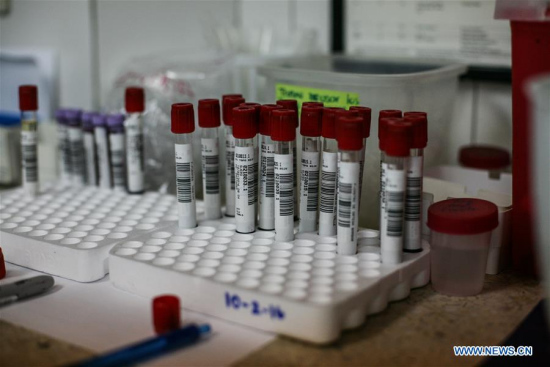
Test tubes are stored at the Salud Chacao Laboratory in Caracas, Venezuela, on Feb. 10, 2016. A total of 31 organizations announced Wednesday that they will share data and results relevant to the current Zika crisis and future public health emergencies as rapidly and openly as possible. (Photo: Xinhua/Boris Vergara)
A senior official from the World Health Organization (WHO) said here Tuesday that currently 34 countries have reported the Zika virus, mostly in the Americas and Caribbean, and seven reported an increase in cases of microcephaly.
Natela Menabde, the executive director of the WHO Office in New York, told UN member states during a briefing to the UN Economic and Social Council (ECOSOC) that Brazil has registered more than 4,700 suspected cases of microcephaly and a quarter were only studied for the moment. Before the outbreak of the virus, the average number of microcephaly every year was of 163 cases.
"The increase we see now is definitely a source of serious concern," she said.
Upon the Zika virus outbreak, WHO launched a global strategy to guide the international response to the spread of the virus and the neonatal malformations and neurological conditions associated with it, she said.
The strategy, also known as the Strategic Response Framework and Joint Operations Plan, focuses on mobilizing and coordinating partners, experts and resources to help countries enhance surveillance of the Zika virus and disorders that could be linked to it, improve vector control, effectively communicate risks, guidance and protection measures, provide medical care to those affected and fast-track research and development of vaccines, diagnostics and therapeutics.
She said that 56 million U.S. dollars are required to implement the strategy, of which 25 million dollars would fund the joint response of WHO, the Regional Office foe the Americas (AMRO) and the Pan American Health Organization (PAHO) and 31 million dollars would fund the work of key partners.
In the interim, WHO has tapped a recently established emergency contingency fund to finance its initial operations, she said.
As art of WHO's new emergency program, the global health agency activated an Incident Management System to oversee the global response and leverage expertise from across the organization to address the crisis. WHO is tapping a recently established emergency contingency fund to finance its initial operations.
In his remarks, ECOSOC President Oh Joon, who is the permanent representative of South Korea to the UN, recalled that on Feb. 1, based on recommendations of the International Health Regulations Emergency Committee, WHO declared the increasing cases of neonatal and neurological disorders amid the growing Zika outbreak in the Americas a public health emergency.
Zika is a virus transmitted by the Aedes mosquito. It was first discovered in 1947 in the Zika forest of Uganda.
"The health threat associated with the Zika Virus disease in Latin America and the Caribbean is very real," he said, adding that the rise of microcephaly cases and other neurological disorders in the affected regions is extremely worrying.
All this raises the question of preparedness of health systems and institutions to respond to the needs of infected women and men, children born with microcephaly, and their families, especially their mothers, he said.
Over the years, ECOSOC convened special meetings to address global public health emergencies and promote a coordinated strategic response to, among others the outbreak of severe acute respiratory syndrome (SARS) in 2003, avian flu in 2005 and Ebola in 2014.
"We have learned from the past outbreaks that health emergencies have economic and social implications," Oh said.


















































